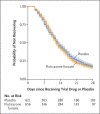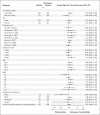Inhaled Fluticasone Furoate for Outpatient Treatment of Covid-19
- PMID: 37733308
- PMCID: PMC10597427
- DOI: 10.1056/NEJMoa2209421
Inhaled Fluticasone Furoate for Outpatient Treatment of Covid-19
Abstract
Background: The effectiveness of inhaled glucocorticoids in shortening the time to symptom resolution or preventing hospitalization or death among outpatients with mild-to-moderate coronavirus disease 2019 (Covid-19) is unclear.
Methods: We conducted a decentralized, double-blind, randomized, placebo-controlled platform trial in the United States to assess the use of repurposed medications in outpatients with confirmed coronavirus disease 2019 (Covid-19). Nonhospitalized adults 30 years of age or older who had at least two symptoms of acute infection that had been present for no more than 7 days before enrollment were randomly assigned to receive inhaled fluticasone furoate at a dose of 200 μg once daily for 14 days or placebo. The primary outcome was the time to sustained recovery, defined as the third of 3 consecutive days without symptoms. Key secondary outcomes included hospitalization or death by day 28 and a composite outcome of the need for an urgent-care or emergency department visit or hospitalization or death through day 28.
Results: Of the 1407 enrolled participants who underwent randomization, 715 were assigned to receive inhaled fluticasone furoate and 692 to receive placebo, and 656 and 621, respectively, were included in the analysis. There was no evidence that the use of fluticasone furoate resulted in a shorter time to recovery than placebo (hazard ratio, 1.01; 95% credible interval, 0.91 to 1.12; posterior probability of benefit [defined as a hazard ratio >1], 0.56). A total of 24 participants (3.7%) in the fluticasone furoate group had urgent-care or emergency department visits or were hospitalized, as compared with 13 participants (2.1%) in the placebo group (hazard ratio, 1.9; 95% credible interval, 0.8 to 3.5). Three participants in each group were hospitalized, and no deaths occurred. Adverse events were uncommon in both groups.
Conclusions: Treatment with inhaled fluticasone furoate for 14 days did not result in a shorter time to recovery than placebo among outpatients with Covid-19 in the United States. (Funded by the National Center for Advancing Translational Sciences and others; ACTIV-6 ClinicalTrials.gov number, NCT04885530.).
Copyright © 2023 Massachusetts Medical Society.
Figures



Comment in
-
Kortikoide in Covid-Frühphase wohl nutzlos.MMW Fortschr Med. 2024 Jan;166(1):28. doi: 10.1007/s15006-024-3569-0. MMW Fortschr Med. 2024. PMID: 38261195 Review. German. No abstract available.
References
Publication types
MeSH terms
Substances
Associated data
Grants and funding
LinkOut - more resources
Full Text Sources
Medical
